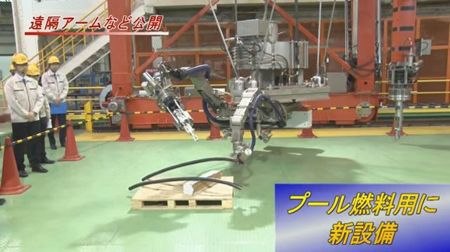-
Tips for becoming a good boxer - November 6, 2020
-
7 expert tips for making your hens night a memorable one - November 6, 2020
-
5 reasons to host your Christmas party on a cruise boat - November 6, 2020
-
What to do when you’re charged with a crime - November 6, 2020
-
Should you get one or multiple dogs? Here’s all you need to know - November 3, 2020
-
A Guide: How to Build Your Very Own Magic Mirror - February 14, 2019
-
Our Top Inspirational Baseball Stars - November 24, 2018
-
Five Tech Tools That Will Help You Turn Your Blog into a Business - November 24, 2018
-
How to Indulge on Vacation without Expanding Your Waist - November 9, 2018
-
5 Strategies for Businesses to Appeal to Today’s Increasingly Mobile-Crazed Customers - November 9, 2018
Toshiba’s wrecking-bot will dismantle Fukushima
The only problem? Reactor 3 is now filled with radiation that would be unsafe for any humans who walked inside.
Advertisement
It might be close to half a decadthe e already, but there is still plenty of work to do at the Fukushima nuclear power plant in Japan when it comes to cleaning up radioactive waste. That fact led Toshiba to the creation of the robot to remove debris and rods from the cooling pool. Now, it looks like they’ve come up with a solution: wrecking and clean-up robots.
As you’d expect, the machine also incorporates several cameras for relaying video from a variety of angles to remote operators, allowing for precision control of the robot – vital for such a precarious operation.
Tokyo Electric Power Co says that it is working to reduce radiation levels in the reactor 3 building, but that radiation levels are still too high for humans to monitor the removal of fuel rods. The robot will begin the work of removing 566 fuel rod assemblies in fiscal 2017. After more than four years of cleanup of radiation in the area surrounding the plant, the Japanese government is ready to dismantle the defunct plant using robots.
Compared with that job, the removal of the fuel-rod assemblies from the reactor 3 pool will be “more hard since it will have to be done completely remotely”, Tepco official Isao Shirai said.
Advertisement
Efforts to clean up Fukushima, which is considered the largest nuclear disaster since the Chernobyl accident in 1986, are under continued scrutiny after a series of blunders and Tepco’s admission that efforts in the short term to contain contamination may take as long as 30-40 years. The Japan Atomic Energy Agency developed a 3-D virtual reality program of the interior of one of the Fukushima reactor buildings for cleanup crew to have a better insight into the layout of the plant.




























